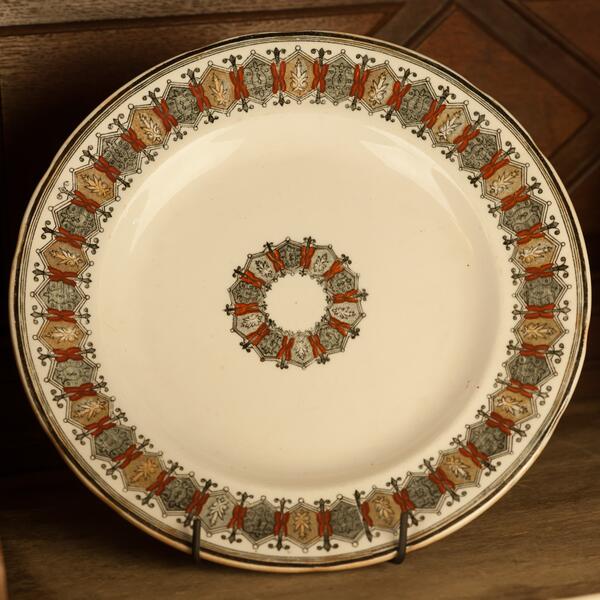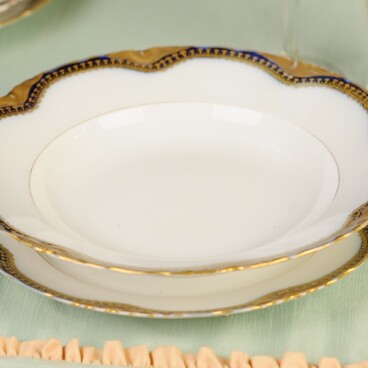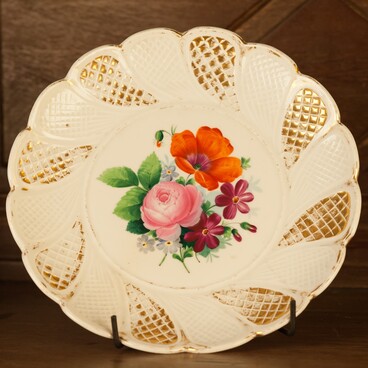The plate on display is a product of M.S. Kuznetsov Partnership Manufacture of Porcelain and Faience in Tver. It was a commonly used item of household faience tableware. By the end of the 19th faience had become mass-produced thanks to the introduction of new mechanical aids.
The plate is made of white faience and has a canted, slightly cut-out round rim. Printed on the surface of the lip is a pattern of ornamented hexagonal shields held together by double-edges tridents.
In 1870 Matvei Kuznetsov expanded his porcelain and ceramics empire by buying the former Auerbach factory in the Tver region. All the factories owned by Kuznetsov were immensely profitable due to his entrepreneurial talen that he had probably inherited from his ancestors. All of them were from Gzhel, a renowned center of traditional blue-and-white ceramics production. The dynasty of porcelain industrialists was founded by his great-grandfather, Yakov Kuznetsov.
Altogether, Kuznetsov factories employed 1300 full-time workers and 4000 part-time workers. Kuznetsov had his wares in 10 major cities of Russia. Kuznetsov managed to conquer foreign markets and become a decent competitor to European porcelain manufacturers. Items produced by the ‘Kuznetsov Porcelain Empire’ was top-quality and was awarded with Gold medals at the Fairs in Paris and Tashkent. Porcelain and faience tableware were in high demand not only in Russia, but also in Turkey, Persia (modern-day Iran), Bulgaria, Japan, United States, Austria, India, etc.
Along with traditional under- and on-glaze painting Kuznetsov factories widely used new technical aids such as printing and stencils. It allowed for lower prices and bigger production rates. Kuznetsov used almost all types of decoration in his faience tableware. As for porcelains, imitations of ‘machine-made’ European samples were used along with traditional hand painting.
Kuznetsov porcelain and faience played an important role in the history of applied arts in Russia. However, it was not until the 1970s when it was finally duly appreciated by researchers.
The plate is made of white faience and has a canted, slightly cut-out round rim. Printed on the surface of the lip is a pattern of ornamented hexagonal shields held together by double-edges tridents.
In 1870 Matvei Kuznetsov expanded his porcelain and ceramics empire by buying the former Auerbach factory in the Tver region. All the factories owned by Kuznetsov were immensely profitable due to his entrepreneurial talen that he had probably inherited from his ancestors. All of them were from Gzhel, a renowned center of traditional blue-and-white ceramics production. The dynasty of porcelain industrialists was founded by his great-grandfather, Yakov Kuznetsov.
Altogether, Kuznetsov factories employed 1300 full-time workers and 4000 part-time workers. Kuznetsov had his wares in 10 major cities of Russia. Kuznetsov managed to conquer foreign markets and become a decent competitor to European porcelain manufacturers. Items produced by the ‘Kuznetsov Porcelain Empire’ was top-quality and was awarded with Gold medals at the Fairs in Paris and Tashkent. Porcelain and faience tableware were in high demand not only in Russia, but also in Turkey, Persia (modern-day Iran), Bulgaria, Japan, United States, Austria, India, etc.
Along with traditional under- and on-glaze painting Kuznetsov factories widely used new technical aids such as printing and stencils. It allowed for lower prices and bigger production rates. Kuznetsov used almost all types of decoration in his faience tableware. As for porcelains, imitations of ‘machine-made’ European samples were used along with traditional hand painting.
Kuznetsov porcelain and faience played an important role in the history of applied arts in Russia. However, it was not until the 1970s when it was finally duly appreciated by researchers.



